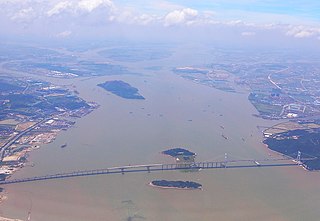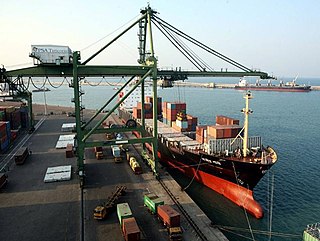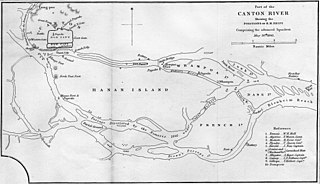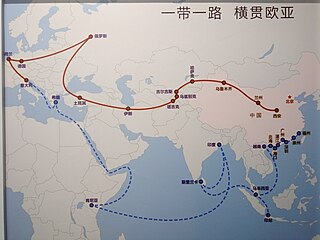
Guangzhou, also known as Canton and alternately romanized as Kwangchow, is the capital and most populous city of the province of Guangdong in southern China. On the Pearl River about 120 km (75 mi) north-northwest of Hong Kong and 145 km (90 mi) north of Macau, Guangzhou has a history of over 2,200 years and was a major terminus of the maritime Silk Road, and continues to serve as a major port and transportation hub, as well as one of China's three largest cities. Long the only Chinese port accessible to most foreign traders, Guangzhou was captured by the British during the First Opium War. No longer enjoying a monopoly after the war, it lost trade to other ports such as Hong Kong and Shanghai, but continued to serve as a major transshipment port. Due to a high urban population and large volumes of port traffic, Guangzhou is classified as a Large-Port Megacity, the largest type of port-city in the world.

A port is a maritime facility which may comprise one or more wharves where ships may dock to load and discharge passengers and cargo. Although usually situated on a sea coast or estuary, some ports, such as Hamburg, Manchester and Duluth, are many miles inland, with access to the sea via river or canal. Because of their roles as a port of entry for immigrants many port cities such as London, New York, Shanghai, Los Angeles, Singapore and Vancouver have experienced dramatic multi-ethnic and multicultural changes.

The Port of Los Angeles, also promoted as "America's Port", is a seaport managed by the Los Angeles Harbor Department, a unit of the City of Los Angeles. It occupies 7,500 acres (3,000 ha) of land and water along 43 mi (69 km) of waterfront and adjoins the separate Port of Long Beach. The port is located in San Pedro Bay in the San Pedro and Wilmington neighborhoods of Los Angeles, approximately 20 miles (32 km) south of downtown.

The Port of Singapore refers to the collective facilities and terminals that conduct maritime trade, and which handle Singapore's harbours and shipping. It is ranked as the top maritime capital of the world since 2015. Currently the world's second-busiest port in terms of total shipping tonnage, it also transships a fifth of the world's shipping containers, half of the world's annual supply of crude oil, and is the world's busiest transshipment port. It was also the busiest port in terms of total cargo tonnage handled until 2005 when it was surpassed by the Port of Shanghai. Thousands of ships drop anchor in the harbour, connecting the port to over 600 other ports in 123 countries and spread over six continents.

The Port of Shanghai, located in the vicinity of Shanghai, comprises a deep-sea port and a river port.

Kilindini Harbour is a large, natural deep-water inlet extending inland from Mombasa, Kenya. It is 25–30 fathoms (46–55 m) at its deepest center, although the controlling depth is the outer channel in the port approaches with a dredged depth of 17.5 m (57 ft). It serves as the harbour for Mombasa, with a hinterland extending to Uganda. Kilindini Harbour is the main part of the Port of Mombasa, the only international seaport in Kenya and the biggest port in east Africa. It is managed by the Kenya Ports Authority (KPA). Apart from cargo handling, Mombasa is frequented by cruise ships.

The Humen, also Bocca Tigris or Bogue, is a narrow strait in the Pearl River Delta that separates Shiziyang in the north and Lingdingyang in the south near Humen Town in China's Guangdong Province. It is the site of the Pearl River's discharge into the South China Sea. It contains the Port of Humen at Humen Town. The strait is formed by the islands of Chuenpi and Anunghoy on the eastern side, and Taikoktow on the western side. Since 1997, the strait has been traversed by the Humen Pearl River Bridge.
The Port of Ningbo-Zhoushan is a port that is the busiest in the world in terms of cargo tonnage. It handled 888.96 million tons of cargo in 2015. The port is located in Ningbo and Zhoushan, on the coast of the East China Sea, in Zhejiang province on the southeast end of Hangzhou Bay, across which it faces the municipality of Shanghai.

The Port of Xiamen is an important deep water port located on Xiamen Island, the adjacent mainland coast, and along the estuary of the Jiulongjiang River in southern Fujian, China. It is one of the trunk line ports in the Asia-Pacific region. It is ranked the 8th-largest container port in China and ranks 17th in the world. It is the 4th port in China with the capacity to handle 6th-generation large container vessels. In 2013, Xiamen handled 191 million tons of cargo, including 8.08 million TEUs of containers. On 31 August 2010, Xiamen Port incorporated the neighboring port of Zhangzhou to form the largest port of China's Southeast. This was a relatively uncommon case of ports merging across jurisdictions.

The Port of Busan is the largest port in South Korea, located in the city of Busan, South Korea. Its location is known as Busan Harbor.

The Port of Manila refers to the collective facilities and terminals that process maritime trade function in harbors that serve the Metro Manila Area. It is located in the Port Area and Tondo areas of Manila, Philippines facing the Manila Bay. It is the largest and the premier international shipping gateway to the country. The Philippine Ports Authority, a government-owned corporation, manages the Port of Manila and most of the public ports in the country. It is composed of 3 major facilities namely Manila North Harbor, Manila South Harbor and the Manila International Container Terminal.

In 1961 China established a state-run maritime shipping company and subsequently signed shipping agreements with many countries, laying the foundation for developing the country's ocean transport. That organization developed into the present-day China Ocean Shipping (Group) Company (COSCO). The Chinese government also invested heavily in water transport infrastructure, constructing new ports and rebuilding and enlarging older facilities.

Lists of ports cover ports of various types, maritime facilities with one or more wharves where ships may dock to load and discharge passengers and cargo. Most are on the sea coast or an estuary, but some are many miles inland, with access to the sea via river or canal. The lists are organized by shipping volume, by ocean or sea, by nation or sub-region, and by other characteristics.

V. O. Chidambaranar Port Trust is one of the 13 major ports in India. It was declared to be a major port on 11 July 1974. It is second-largest port in Tamil Nadu and fourth-largest container terminal in India. After Sethusamudram Shipping Canal Project, V. O. Chidambaranar Port Trust will be India's premier port and one of the major ports of Asia equal to Port of Singapore. V. O. Chidambaranar Port Trust is an artificial port. This is the third international port in Tamil Nadu and its second all-weather port. All V. O. Chidambaranar Port Trust's traffic handling has crossed 10 million tons from 1 April to 13 September 2008, registering a growth rate of 12.08 per cent, surpassing the corresponding previous year handling of 8.96 million tons. It has services to USA, China, Europe, Sri Lanka and Mediterranean countries. The Station Commander, Coast Guard Station Thoothukudi is located at V. O. Chidambaranar Port Trust, Tamil Nadu under the operational and administrative control of the Commander, Coast Guard Region (East), Chennai. The Coast Guard Station V. O. Chidambaranar Port Trust was commissioned on 25 April 1991 by Vice Admiral SW Lakhar, NM, VSM the then Director General Coast Guard. The Station Commander is responsible for Coast Guard operations in this area of jurisdiction in Gulf of Mannar. V. O. Chidambaranar Port Trust Thoothukudi is an ISO 9001:2008, ISO 14001:2004 and ISPS compliant Port.

Xiaoguwei, formerly known in English as French Island, is an island in the Pearl River Delta of China's Guangdong Province. It is now administered as part of Xinzao (新造镇), a town in Guangzhou's Panyu District. The Guangzhou Higher Education Mega Center now occupies the entire island.
The Port of Zhanjiang is a natural deepwater harbor in Southeast China. It was designed and reconstructed as China's first modern port, the project being commenced in 1956. After nearly 50 years of construction, the existing 39 wharves are able to handle the containers, general cargo and bulk cargo that arrives at the port. It also has facilities for dangerous goods, petroleum, chemicals, liquid chemicals, storage, packaging, commercial and transit passengers, ferries, freight forwarding, shipping agents, ship transport, bonded warehouses and exports. Since 2004, the port has become a land, sea and air transport hub.
The Port of Tianjin, formerly known as the Port of Tanggu, is the largest port in Northern China and the main maritime gateway to Beijing. The name "Tianjin Xingang"(Chinese: 天津新港; pinyin: tiānjīn xīngǎng; lit. 'Tianjin New Port'), which strictly speaking refers only to the main seaport area, is sometimes used to refer to the whole port. The Port is located on the western shore of the Bohai Bay, centered on the estuary of the Haihe River, 170 km south east of Beijing and 60 km east of Tianjin city. It is the largest man-made port in mainland China, and one of the largest in the world. It covers 121 square kilometers of land surface, with over 31.9 km of quay shoreline and 151 production berths at the end of 2010.
The Port of Fuzhou is a natural seaport centered on the estuary of the Minjiang River artificial deep-water international seaport on the coast of Fuzhou, Fujian, People's Republic of China. and of the neighboring prefecture of Ningde. The Port is located on the southeastern coast of Fujian, facing the Taiwan Strait. Fuzhou is the Mainland port closest to Taiwan, being just 149 Nautical miles from Keelung.

The 21st Century Maritime Silk Road, commonly just Maritime Silk Road (MSR), is the sea route part of the Belt and Road Initiative which is a Chinese strategic initiative to increase investment and foster collaboration across the historic Silk Road. The project builds on the maritime expedition routes of Admiral Zheng He.

The Guangdong-Hong Kong-Macau Greater Bay Area also referred as Greater Bay Area (GBA), is a megalopolis, consisting of nine cities and two special administrative regions in South China. On 7 December 2016, the concept for the area was mentioned in the English version of China's 13th Five-Year Plan. On 13 April 2017, the heading of a piece of news released at the English.gov.cn website of the State Council adopted the name "Guangdong-Hong Kong-Macao Bay Area". Just over two months later, on 1 July 2017, the "Framework Agreement on Deepening Guangdong - Hong Kong - Macau Cooperation in the Development of the Bay Area" was signed in Hong Kong.















